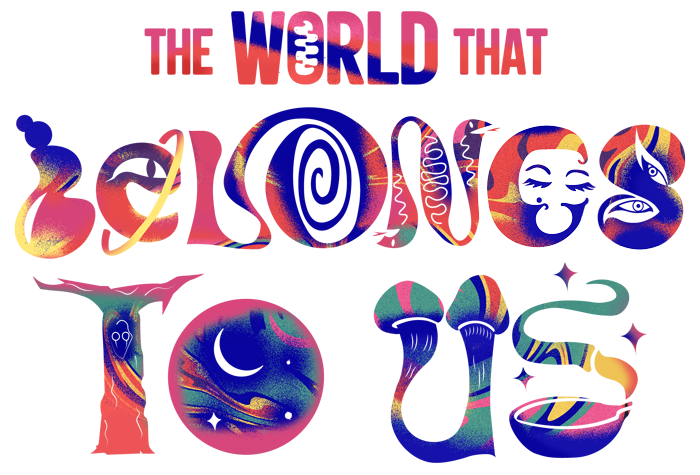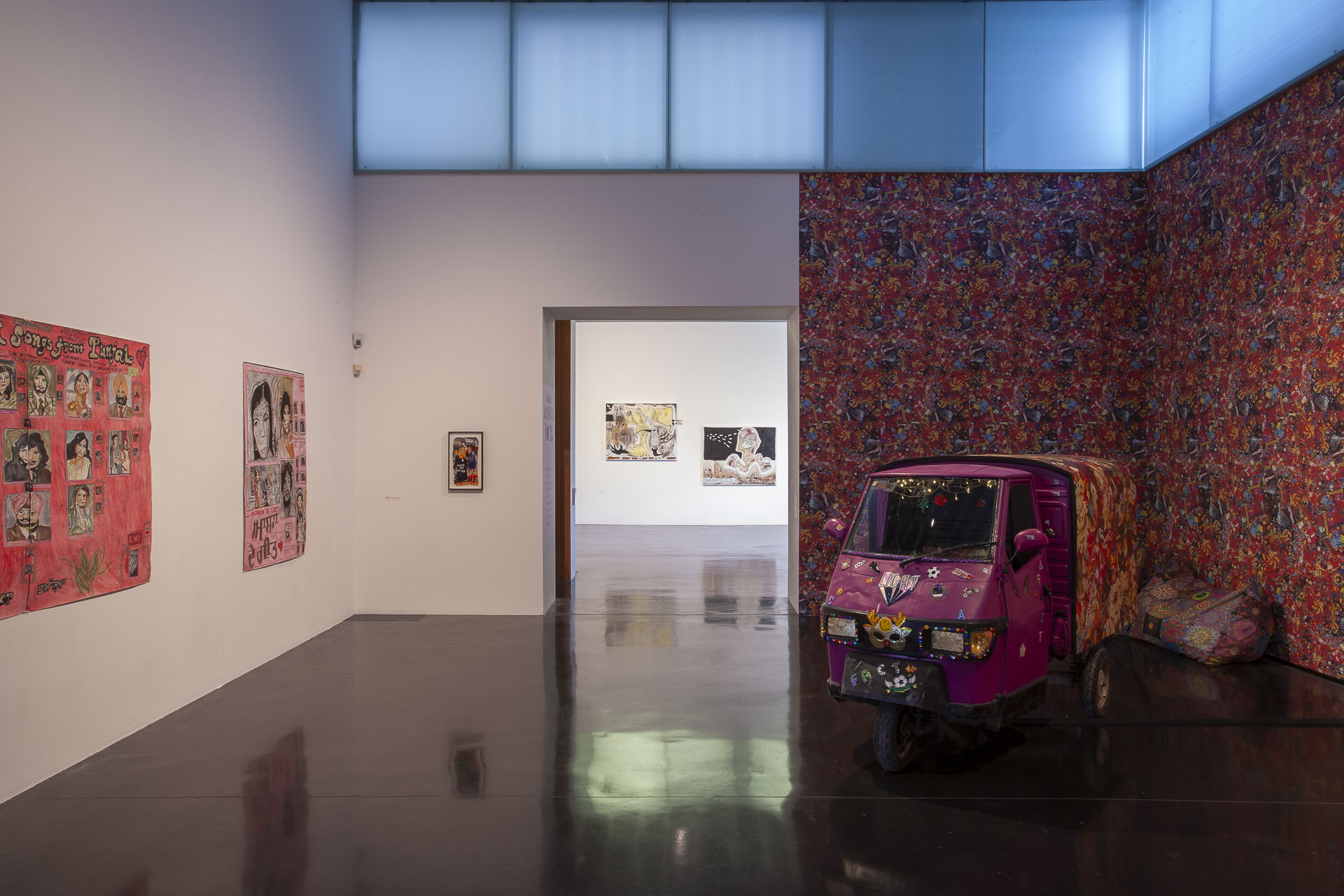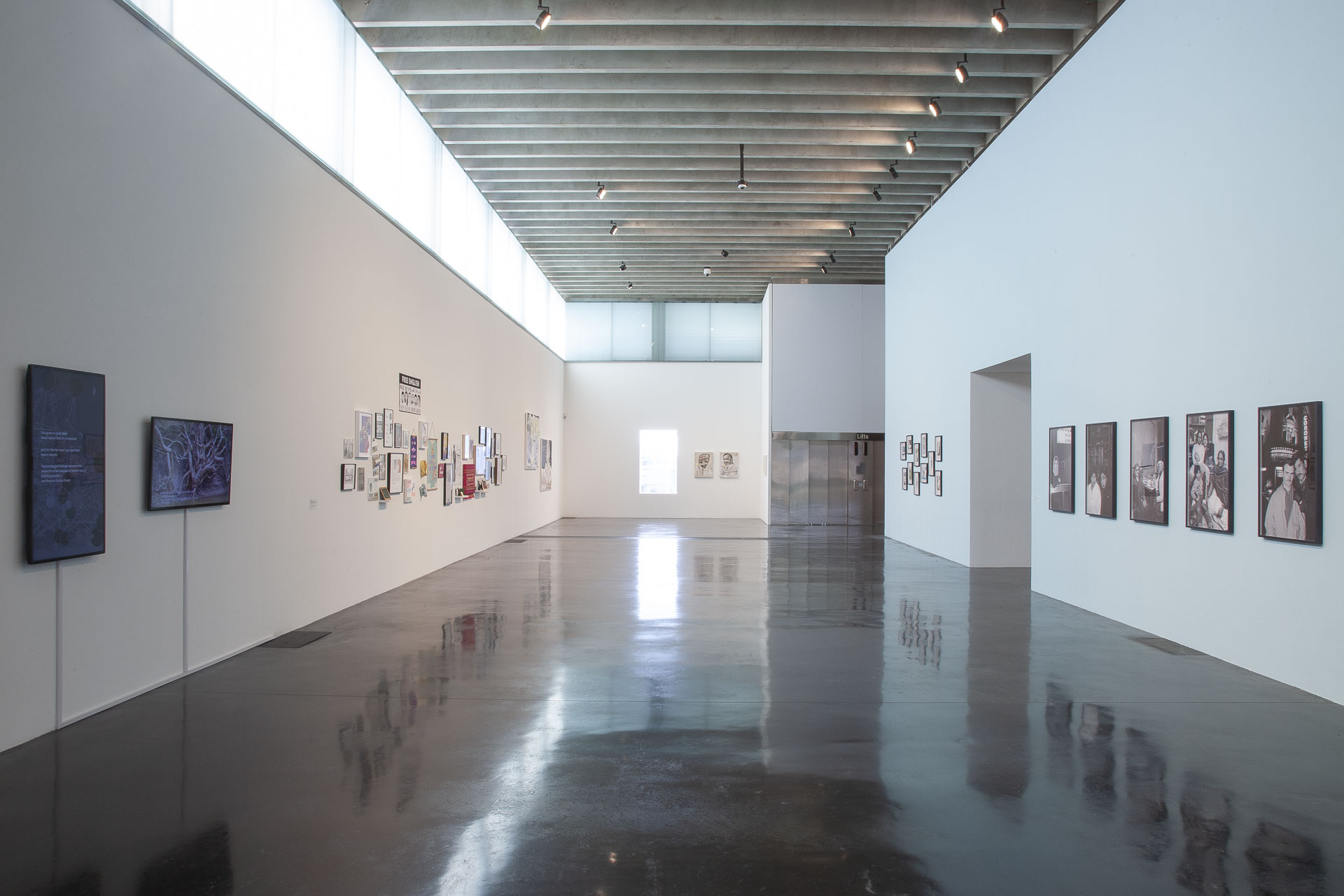
Exhibition Guide
By Aziz Sohail and Deborah Robinson, Co-curators
The World that Belongs to Us* brings together a constellation of intergenerational artists from the South Asian diasporas of the UK, USA and Canada. The exhibition explores ways in which these artists challenge mainstream narratives, resist exclusion and erasure and build communities and spaces for themselves both within the art world and the diaspora.

The World That Belongs to Us, installation view at The New Art Gallery Walsall. © 2024. Photo by Johnathan Shaw
Sharing a common thread of combining autobiography and activism and working across a range of media including painting, photography, film, animation, wall drawing and site specific installation, the works on display activate interrelated conversations around community and belonging, friendship and intimacy, migrant storytelling and queer and feminist world-making.
Honouring the location of the Gallery in the West Midlands with its multicultural communities and its legacy of championing artists from diverse backgrounds, the exhibition takes inspiration from the trailblazing scholarship of Stuart Hall. Hall argued for culture to be considered as a site from where power could be challenged and wrote extensively about diaspora as a continued negotiation of identity and difference. To this end, the exhibition includes the series Body Weapons by Chila Kumari Singh Burman and Changing Spaces by Roshini Kempadoo. Both important figures within the Black Arts Movement, the artists were commissioned to create new work for the 1993 exhibition Confrontations which were acquired for the Gallery’s Permanent Collection; these works are re-presented and re-contextualised.
Burman is widely celebrated for her radical and influential feminist practice. For her, the self-portrait has frequently been used as a tool for empowerment and self-determination. In this exhibition, Body Weapons (1993) is placed within a multi-media installation comprising printed wallpaper, a sumptuously decorated Tuk Tuk and three films from across three decades, weaving together family history, popular culture and Punjabi psychedelia. More recent neon works by Burman can be seen in the Gallery’s street level Window Box.

The World That Belongs to Us, installation view at The New Art Gallery Walsall. © 2024. Photo by Johnathan Shaw
Kempadoo’s photographic series Changing Spaces (1993), reflects on mixed race relationships and questions fixed notions about identity. In addition, the exhibition presents Kissing Life Better (2023), a new two
channel video which celebrates the work of women activists committed to transformative climate justice. The work investigates the impact of industrial scale extraction in two continents connected by British colonial trading routes, focusing on the impact of gold mining in Guyana and industrial logging and degraded water sources in Kenya.
Another immersive environment is created by the New York based artist Chitra Ganesh. Her film Before the War (2022), shown for the first time in Europe, is presented as part of an installation, which includes a newly commissioned wall drawing and a series of prints. Ganesh’s wide-ranging practice draws on source material including mythology and science fiction, literature and graphic novels, video games and popular culture, to create works which disrupt conventions of gender and sexuality and become celebrations of queer and feminist joy and power. Before the War features music by Saul Williams and in the artist’s words, is “an open-ended narrative of memory, love and loss.”
Further siting the exhibition within the Midlands, the exhibition presents Arrival by Sunil Gupta and Charan Singh, which was commissioned by Fierce as part of a cultural programme accompanying the 2022 Commonwealth Games held in Birmingham. Many Commonwealth countries still retain discriminatory laws against queer people, a legacy and impact of British colonialism. Working with LGBTQ+ asylum seekers and
refugees from around the UK, Arrival is a compelling series of photographic works, honouring these stories
and diverse identities.
Like Burman and Kempadoo, Sunil Gupta’s individual practice can also be seen within a history of the Black Arts Movement. His influential photographic and curatorial practice has remained committed to social and political commentary, particularly around themes of race, migration and queer identity. The series Black
Experience was commissioned by the Greater London Council for the exhibition Reflections of the Black Experience curated by Monika Baker at the Brixton Art Gallery in 1986, at a time when the prevailing term in the UK to describe any person of colour was Black. The participating artists were commissioned to create work which documented “the social, cultural and political changes” in Britain at that time. Gupta’s approach was to create a series of images about the diverse range of Asian experiences in London.
Inspired by their own personal migration history, Ohio based Sa’dia Rehman has produced a new site-specific wall work. Rehman’s father’s home was in Khar Kot, near the Indus River in northern Pakistan, which was one of around 184 villages destroyed due to the building of the Tarbela Dam which displaced more than 100,000
people. Through their work, Rehman draws connections with the Mirpuri diaspora in the UK, which emerged from another dam project in Pakistan – the building of the Mangla Dam. To this end, the drawing includes works created in conversation with the London based graphic novelist Sabba Khan, creating kinship through shared migrant stories and experiences.
Chronicling stories relating to migration through the reexamination of archives is also central to Birmingham born, Toronto based Pamila Matharu’s practice. INDEX (SOME OF ALL PARTS) is an ongoing installation consisting of paintings and collage, family photographs, found objects, posters, newspaper and magazine articles with references to music and literature. Initiated in 2019, the varied elements map personal history within Matharu’s life in relation to national and collective narratives, activating conversations around exclusion, erasure and the complex nature of identity within today’s multicultural societies.

The World That Belongs to Us, installation view at The New Art Gallery Walsall. © 2024. Photo by Johnathan Shaw
Through his practice, Glasgowbased Hardeep Pandhal explores notions of belonging, displacement, historical violence and cultural assimilation. The exhibition includes a seldom seen series of works Sikh Soldiers (2012), created by the artist early in his career. Presented as cartoon-like characters, these works address the archetypal representation of the Sikh soldier or warrior in colonial history combined with both real and fictional characters associated with science fiction, video games and films, challenging ideas around masculinity, inclusion and representation. Continuing to draw on themes of play and gaming, the artist has invented the character Sepoy Man for a series of new works within the exhibition.
The figurative drawings and poignant textile-based works of Canadian interdisciplinary artist Jagdeep Raina illustrate and reimagine stories and scenes from across Kashmiri and Punjabi diasporas. His practice draws on anecdotal histories as well as personal and public archives. Significantly, Raina deploys the Phulkari, an embroidered textile which originated in the rural villages of the Punjab before Partition, to reconsider shared legacies of colonialism, globalisation, activism and community.
New York based artist Salman Toor is known for his enigmatic paintings and drawings that focus largely around everyday lives and intimacies of brown, queer men. Sometimes heartening and sometimes harrowing, these seductive and poignant works reveal both joy and vulnerability and the value of community in the context of queer, diasporic identity. The works on display instigate multi-layered, nuanced and complex conversations with each other, allowing for networks and relationships to emerge across time and space. Set against a backdrop of heightened and difficult debates about immigration in the UK, the perceived failures and possibilities of multiculturalism and a reexamination of historical and colonial legacies and responsibilities, this exhibition celebrates joy, pleasure and magic; the power of making and imagining otherwise worlds; and emphasises community making and collaboration as a means of resistance and survival.


